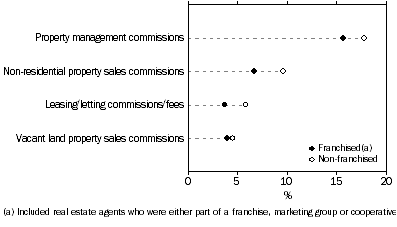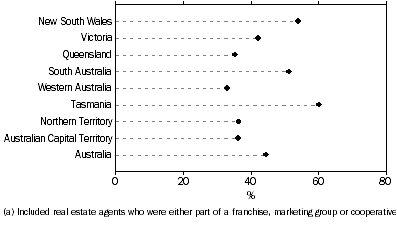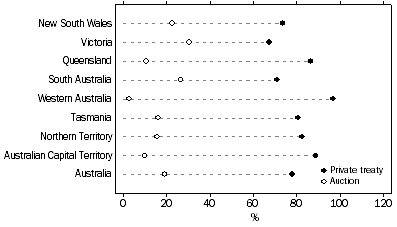INTRODUCTION
This publication presents results from an Australian Bureau of Statistics (ABS) survey of businesses involved in real estate services. The survey was conducted in respect of the 2002-03 financial year.
The 2002-03 Real Estate Services Survey is the fifth ABS survey on this topic, with previous collections being conducted in respect of the 1998-99, 1995-96, 1992-93 and 1987-88 financial years. The 2002-03 survey has expanded its content to include information on franchised and non-franchised real estate agents.
COMPARISONS WITH PREVIOUS SURVEY RESULTS
This survey has been designed to provide a measure of the financial and business structure of real estate services businesses operating in Australia. While comparisons are made between 2002-03 survey results and the earlier iterations of the Real Estate Services Survey, the survey has not been designed to provide highly accurate estimates of change, so any comparisons made to the previous surveys should be used with caution. For further information, see paragraphs 21-23 of the Explanatory Notes.
MORE INFORMATION ON ABS SERVICE INDUSTRIES STATISTICS
Information about ABS activities in the field of service industries statistics is available from the Service Industries Statistics theme page on the ABS web site <https://www.abs.gov.au>. To access the theme page, select 'Themes' from the menu on the home page.
COMMENTS
The ABS welcomes comments and suggestions from users regarding future surveys of Service Industries. These comments should be addressed to the Director, Service Industries Business Statistics Centre, Australian Bureau of Statistics, GPO Box 2796Y, Melbourne, Vic. 3001.
ROUNDING
Where figures have been rounded, discrepancies may occur between the sum of component items and the total.
ABBREVIATIONS
| $m | million dollars |
| ABN | Australian Business Number |
| ABS | Australian Bureau of Statistics |
| ANZSIC | Australian and New Zealand Standard Industrial Classification |
| ATO | Australian Taxation Office |
| GDP | gross domestic product |
| GE | group employer |
| IVA | industry value added |
| OPBT | operating profit before tax |
| PAYGW | pay-as-you-go withholding |
| RSE | relative standard error |
| SE | standard error |
| TAU | type of activity unit |
| TNTS | The New Tax System |
INQUIRIES
For further information about these and related statistics, contact the National Information and Referral Service on 1300 135 070 or Marie Apostolou on Melbourne 03 9615 7465.
MAIN FEATURES
INTRODUCTION
This publication presents the results of the 2002-03 Real Estate Services Survey. This survey is conducted periodically by the ABS to provide a detailed measure of the performance and structure of real estate services businesses operating in Australia. The main focus of the survey was on understanding the composition of the income earned by these businesses, details of expenses incurred and the characteristics of the workforce. A state dimension is also presented.
The survey scope included employing businesses in Australia that generated income predominantly from real estate services. Real estate services included: valuing, purchasing, selling (by auction or private treaty), and managing or renting real estate for others.
Table 1 contains summary information for all businesses undertaking real estate services. Tables 2-9 present statistics on real estate agents.
REAL ESTATE SERVICES BUSINESSES
Summary of findings
At the end of June 2003 there were 10,001 real estate services businesses operating in Australia, comprising 3,639 franchised real estate agents, 4,545 non-franchised agents and 1,818 other real estate services businesses. These businesses combined had employment of 76,599 persons.
During 2002-03, income generated by these businesses was $7,524.7m, representing an average of $98,200 per person employed. Franchised real estate agents generated $3,672.9m in income, while non-franchised agents generated $3,145.7m.
Total expenses incurred for this same period by all real estate services businesses were $6,634.6m.
The total industry value added (IVA) by real estate services businesses was $4,784.1m, contributing the equivalent of 0.6% to Australian Gross Domestic Product (GDP) for 2002-03. Equivalent contribution to Property and Business Services industry gross value added was 6%.
Historical comparison
Comparisons with results from earlier surveys are useful as an indication of the extent of change over time. However, the survey was not designed to provide highly accurate estimates of change, so any comparisons to results from previous surveys should be made with caution. Estimates of change can be subject to changes to scope and coverage or question wording, or high levels of sampling error. Further information can be found in paragraphs 21-23 in the Explanatory Notes.
Taking into consideration these limitations, the 2002-03 survey results suggest that real estate services experienced a period of significant growth between 1998-99 and 2002-03.
Total income had an average growth rate of 17.8% per annum since 1998-99. This increase can be largely attributed to the property boom experienced across Australia. The main source of income was income from property sales and leasing commissions which grew at an average annual rate of 20.9%. Income from property management commissions also experienced growth (average annual rate of 8.3%), but not as strong as property sales.
The number of real estate services businesses increased from 7,589 at the end of June 1999 to 10,001 at the end of June 2003; an average annual percentage change of 7.1%.
The average annual percentage change for employment was 10.1%. Employment grew from 52,079 persons in 1998-99 to 76,599 persons in 2002-03.
Labour costs rose by an annual average of 18.4%.
REAL ESTATE AGENT BUSINESSES
The following information presents the results for real estate agent businesses only. New to the survey are data on franchised and non-franchised real estate agency businesses.
Income
Real estate agents generated $6,818.7m in income during 2002-03. Franchised agents contributed $3,672.9m (53.9%) to the total, while non-franchised agents contributed $3,145.7m (46.1%).
Income from property sales commissions was the major source of income generating $5,000.6m in income (73.3% of total income). This mainly comprised: residential properties ($4,162.7m), commercial, industrial and retail properties ($523.8m) and residential vacant land ($231.3m).
Income from property management commissions accounted for the second highest source of income, $1,135.2m (or 16.6% of total income). This total was generated through sales commissions for residential properties ($801.7m) and non-residential properties ($290.2m) and body corporate management fees ($43.3m).
Private treaty was the most common type of sale of property in Australia, with 78% of all income from property sales commissions generated this way. Sales commission income generated through sale by auction comprised 19.3% of the total.
The sources of income for franchised and non-franchised agents did not differ substantially, however there were some variations in the level of income generated as a proportion of total income for all sources. The majority of income for both franchised and non-franchised agents was generated from residential property sales commissions. Franchised agents generated a higher proportion of their total income from this source (65.6%) than non-franchised agents (55.7%).
The graph below shows that non-franchised agents accounted for a higher proportion of income from the following sources: income from property management commissions (17.8%), property sales commissions for non-residential properties (9.6%) and vacant land (4.5%) and leasing/letting commissions/fees (5.8%). The same values for these sources for franchised agents were: 15.6%, 6.7%, 4%, and 3.7% respectively.
Selected sources of income by type of real estate agent, Proportion of total income

Size of business
Real estate agents tended to be small employers: 39% had 4 or fewer persons employed, 34.1% had 5-9 persons and 20.6% had 10-19 persons. Only 0.6% of businesses had employment of 50 or more persons.
Micro businesses (those with 0-4 persons) generated 11.4% of total income, and had an average income of $95,000 per person employed. Businesses with employment of 10-19 persons generated the highest income as a proportion of total income, 33.9% ($2,309.8m), averaging $106,500 per person employed. Large employers (those with 100 or more persons) comprised 0.2% of total businesses in Australia and generated $526.9m in income. These businesses had an average income of $111,800 per person employed.
Profit margins were fairly similar across most business sizes ranging from 10.2% for businesses with 5-9 persons employed to 14.4% for those with 0-4 persons. Larger businesses (100 or more persons) had the lowest profit margin at 6.3%. A contributing factor to the higher profit margin for micro businesses was the fact that some of these businesses were operated by sole proprietors and partners; the drawings of these persons were excluded from business expenses, and thus profit calculations.
Employment
At the end of June 2003, real estate agents had total employment of 67,934 persons, comprising 35,988 persons in franchised agencies and 31,946 persons in non-franchised agencies.
The majority of employment comprised permanent full-time employees (43,527 persons or 64.1%). Permanent part-time and casual employment was less prevalent at 5,978 persons (8.8%) and 5,454 persons (8%) respectively.
There were 9,426 working directors of incorporated businesses and 3,549 working proprietors and partners of unincorporated businesses at the end of June 2003, accounting for 19.1% of total employment.
Females represented 55% (37,341) of total employment in real estate agencies.
There were more females in most types of employment status. Females accounted for 56.5% of all permanent full-time, 79.6% of all permanent part-time and 74.4% of all casual employees. Males accounted for the majority of working proprietors/partners and directors (69.8%).
Staff were more likely to be employed as real estate salespersons (25,910 persons or 38.1%), while property managers were the next highest occupation group with 13,301 staff (19.6%), followed by real estate agency managers (9,120 or 13.4%).
There were more females in property management, 73.7% (9,797 staff), while males largely occupied real estate agency manager (74.2% or 6,770 staff) and real estate sales positions (66.7% or 17,291 staff).
Expenditure
Total expenses for real estate agents for 2002-03 were $6,054.9m. Labour costs were the highest single expense item, $3,299.2m representing 54.5% of total expenditure. The average labour costs per employee was $51,200.
Other key expenses were: advertising and promotional expenses, $585.8m (9.7%), rent, leasing and hiring, $283.9m (4.7%) and other contract, subcontract and commission expenses, $274.4m (4.5%). Advertising and promotional expenses should be used with caution as not all advertising on behalf of clients is expensed through a business's statement of financial performance.
Insurance premiums comprised 1.4% ($82.7m) of total expenditure. Professional indemnity insurance is the most common form of insurance for real estate agents. Over 7,000 businesses paid $52.5m (63.5% of total insurance expenses) in professional indemnity insurance during 2002-03.
Total insurance premium expenses for real estate agents increased from $27.1m in 1998-99 to $52.3m in 2001-02, and $82.7m in 2002-03.
The average professional indemnity insurance premium per business (for real estate agents with this type of insurance) during 2002-03 was $7,400 compared to an average of $5,000 per business in 2001-02.
The predominant expense item for non-franchised businesses was labour costs, comprising 55% of total expenditure for these businesses. Other key expenditure items were advertising and promotional expenses (8.8%), other contract, subcontract and commission expenses (4.8%) and rent, leasing and hiring (4.5%).
Key expenditure for franchised businesses was very similar to that of non-franchised businesses. Labour costs were also the dominant expense for franchised businesses, comprising 54% of total expenditure. Advertising and promotional expenses accounted for a higher proportion of total expenses (10.4%) than for non-franchised businesses, as did rent, leasing and hiring (4.8%).
Profit margin
Operating profit before tax was $753.8m for real estate agents resulting in an operating profit margin of 11.1%. The profit margin for non-franchised agents was 12% during 2002-03, while franchised businesses recorded 10.3%.
States and territories
New South Wales accounted for the highest share of total number of locations, employment and total income (35.8%, 38.6% and 40.1% respectively). Queensland had the next highest share of locations (25%) and total income (21.6%), but had a slightly lower share of employment than Victoria (21.4% for Queensland and 21.9% for Victoria). Victoria's income share was 20.1% and locations 19.6%.
At the end of June 2003, there were 3,639 (44.5%) franchised real estate agent businesses out of a total of 8,184 real estate agency businesses. The following graph shows that Tasmania had the highest proportion of franchised businesses to total Tasmanian real estate businesses, with 60.2%. There were also more franchised businesses in New South Wales (53.9%), and South Australia (51.3%). Western Australia had the lowest concentration of franchised agents with 33.1%, followed by the Australian Capital Territory (36.2%) and Northern Territory (36.4%).
Franchised(a) real estate agents, Proportion of total real estate agent businesses

Franchised agents contributed a slightly higher proportion of income to total income (53.9%) across Australia than non-franchised agents (46.1%).
Despite having a smaller percentage of franchised businesses (36.4%), Northern Territory franchised agents generated a higher proportion of income to total Northern Territory income (68.1%). Queensland also followed this trend with 35.4% of franchised businesses generating 51.8% of total Queensland income.
The following chart shows that property sales commission income is predominantly generated through private treaty rather than auction across Australia. Western Australia had the highest proportion of property sales income through private treaty (96.8%), followed by the Australian Capital Territory (88.9%) and Queensland (86.5%). Income generated through auction was highest in Victoria (30.6%), South Australia (26.5%) and New South Wales (22.7%).
Real estate agents, Income from property sales commissions by type of sale

Web presence
Franchised businesses had a higher prevalence of web presence than non-franchised businesses at the end of June 2003 (98.2% and 65.1% respectively).
Most businesses with a web presence advertised the majority of their properties (80% or more of their listings) via the web. There was only a marginal difference between franchised and non-franchised agents (77.9% and 75.5% respectively).
Tenancies
In Australia there were 6,495 real estate agent businesses managing a total of 1,208,217 residential and 169,492 non-residential tenancies at the end of June 2003. The average number of tenancies managed per business was 212, for those businesses which undertook this activity.
For those businesses that undertook management of tenancies, the size of a business influenced the number of tenancies managed per business. The larger businesses (100 or more persons) managed 2,200 tenancies per business during 2002-03, while micro businesses (less than 5 persons) managed 125 tenancies per business.
1 SUMMARY OF OPERATIONS, Real estate services |
|  |
 |  |  | 1998-99
| 2002-03
|  |
 |  |  | Total | Franchised real estate agents(a) | Non-franchised real estate agents | Other real estate services | Total | Average annual percentage change 1998-99 to 2002-03 |  |
|  |
| Businesses at end June | no. | 7,589 | 3,639 | 4,545 | ^1,818 | 10,001 | 7.1 |  |
| Offices/locations at end June |  |  |  |  |  |  |  |  |
 | Capital city and suburbs | no. | 6,102 | ^3 082 | 3,535 | ^1640 | 8,257 | 7.9 |  |
 | Other | no. | 2,559 | ^1 264 | ^1 666 | *535 | 3,465 | 7.9 |  |
 | Total | no. | 8,661 | 4,346 | 5,201 | ^2 176 | 11,722 | 7.9 |  |
| Employment at end June | no. | 52,079 | 35,988 | 31,946 | ^8 665 | 76,599 | 10.1 |  |
| Income |  |  |  |  |  |  |  |  |
 | Property sales and leasing commissions | $m | 2,502.8 | 2,939.1 | 2,380.2 | *34.1 | 5,353.4 | 20.9 |  |
 | Property management commissions | $m | 925.0 | ^574.8 | 560.3 | *136.2 | 1,271.4 | 8.3 |  |
 | Other | $m | 475.0 | ^159.1 | 205.2 | ^535.8 | ^900.0 | 17.3 |  |
 | Total | $m | 3,902.7 | 3,672.9 | 3,145.7 | ^706.1 | 7,524.7 | 17.8 |  |
| Expenses |  |  |  |  |  |  |  |  |
 | Labour costs | $m | 1,847.5 | 1,776.4 | 1,522.8 | ^326.0 | 3,625.2 | 18.4 |  |
 | Other | $m | 1,590.2 | 1,512.3 | 1,243.5 | ^253.6 | 3,009.3 | 17.3 |  |
 | Total | $m | 3,437.7 | 3,288.7 | 2,766.3 | ^579.6 | 6,634.6 | 17.9 |  |
| Operating profit before tax | $m | 465.0 | ^379.1 | ^374.7 | *124.9 | 878.7 | 17.2 |  |
| Operating profit margin | % | 12.0 | ^10.3 | 12.0 | ^17.8 | 11.7 | . . |  |
| Industry value added | $m | 2,442.4 | 2,260.8 | 2,032.3 | ^490.9 | 4,784.1 | 18.3 |  |
| Businesses with a web presence at end June | % | na | 98.2 | 65.1 | ^27.7 | 70.4 | . . |  |
| Proportion of businesses advertising 80% or more of their property listings via a web presence(b) | % | na | 77.9 | 75.5 | np | 71.7 | . . |  |
|  |
| ^ estimate has a relative standard error of 10% to less than 25% and should be used with caution |
| * estimate has a relative standard error of 25% to 50% and should be used with caution |
| . . not applicable |
| na not available |
| np not available for publication but included in totals where applicable, unless otherwise indicated |
| (a) Included real estate agents who were either part of a franchise, marketing group or cooperative. |
| (b) Proportions were of businesses with a web presence. Of the 79.8% of real estate agent businesses with a web presence, 5.7% did not advertise any properties for sale via the web. |
 Print Page
Print Page
 Print All
Print All